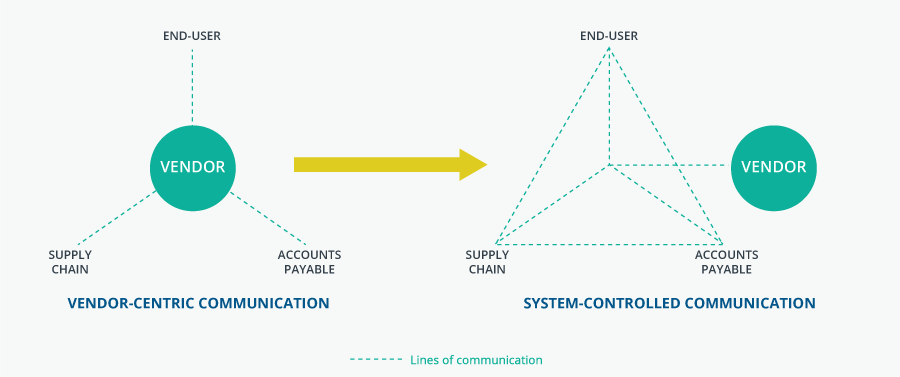
TAG Inc. Announces New Service – Healthcare Supply Chain Consulting
September 21, 2021
Why your Health System Needs Mobile Device Management Help
October 27, 2021The last two years in healthcare has brought on challenges our industry have never experienced with the onset and continuation of COVID-19. As we approach 2022 and begin preparing for a post-pandemic world, we take a look at the top trends in Accounts Payable (AP) throughout the healthcare industry.
5 AP Trends in Healthcare
Disbursed Workforce
The pandemic has brought on the need for remote workers throughout operations in health systems. Particularly with the rise of tech advances such as telemedicine and a move toward a consumer-centric model for healthcare, many healthcare organizations plan to keep the remote working structure in place to save on operating and real estate costs.
According to Gartner, 82% of company leaders plan to allow employees to work remotely at least part of the time after the pandemic. Forty-seven percent of company leaders will allow employees to work from home full-time.
However, this new remote work model poses challenge to our industry’s AP departments. In order to meet the work-from-home needs and demands, AP leaders must streamline processes that used to heavily rely on manual processing such as physically opening mail, running paper checks, and ad hoc exceptions resolution.
To be successful long term, AP Leaders must take action to replace these outdated ways and adopt new technology and processes including:
- Digital tools available from any device (laptops, tablets, smart phones)
- Workflow systems that capture important and hard-to-measure data points
- Cloud security and data warehousing
- Collaboration tools such as Microsoft Teams or Skype
- Proper ERP controls and thorough training of the system
As the move to a work-from-home (WFH) model becomes permanent, new communication and collaboration skills are needed as well as additional ways of developing leadership skills within an organization to ensure employees are connected, engaged, and motivated.
Focus on Automation
Due to many of the issues that the pandemic has brought upon health systems, such as layoffs, staffing shortages, and working with new vendors, AP departments need to rethink workflows. Because of these disruptions, it is now more difficult to determine the appropriate approvers, resolve exceptions with supply chain, and source correct information. These issues, coupled with the countless manual tasks AP endures, have AP staff reporting much longer workdays since the onset of the pandemic.
According to the Institute of Finance & Management (IOFM), 84% of the typical AP FTE’s time is wasted through manual activities.
In order to counteract these challenges, AP must lean into automation tools to process an increased invoice volume with the same or fewer resources.
Examples of Automation AP can utilize:
Electronic data interchange (EDI) for invoicingOCR/Imaging software
Automated approval workflow
Payment optimization including a move to electronic payment methods
Organizations that adopt AP automation are able to streamline their overall procure to pay (P2P) processes and can marshal their resources to survive in the post-pandemic world.
Increasing Business Intelligence with Visualization
As more leaders across healthcare organizations need real-time insights into their processes, payments, and invoicing data, most AP departments in the industry will need to improve their capabilities to serve these organizational needs.
How can health systems do this?
- C-suite leaders must implement crisis preparedness, assess their health system’s financial wellbeing, and get to know their organization at a deeper level to prepare for the future.
- Supply chain leaders must understand how their current spend equates to outcomes, and how that spend is optimized to improve cost, quality, and outcomes (CQO).
- Risk and compliance departments should assess their spend and vendors for possible fraud – especially given the rise of cyberattacks on health systems and hospitals. Cyberattacks shut hospital operations down, costing as much as $45,700 per hour of downtime reported by Becker’s.
- Clinical leaders need to arm themselves with data that helps them to evaluate opportunities for increased standardization.
Increasing AP’s digital capabilities means increased amounts of data to manage, which is both an opportunity and burden. A burden due to the fact that more tools and personnel are needed to analyze and interpret the data, but an opportunity to provide insight into a health system’s spend data – insight no other department can provide such as:
- Better financial forecasting and modeling
- Processing times
- Payment terms optimizations
- P2P control effectiveness, such as use of purchase orders and supplier use optimization
- Team member performance
- Order and invoice volume
However, manually tracking the information necessary to provide that insight is far beyond the capacity of current healthcare AP departments. Adopting digitalization and tracking automation provides the flexibility today’s health systems need. Without the tools and ability to digitize this information, AP will not be able to provide this data to their leaders and their organizations will suffer. Those organizations which embrace this opportunity are the ones who will thrive in the post-pandemic era.
Leveraging KPIs for Efficiency and Improvement
Increasing AP’s business intelligence and visualizations not only provides insight into the financial health of a health system, it also provides much needed information to meet performance metrics and achieve leaner processes.
AP has traditionally been focused on calculating their average days to pay vendor invoices and managing their total volume of transactions on a monthly basis. Now departments can focus on next-level metrics and key performance indicators (KPIs) such as costs of processing a single invoice, days payable outstanding, and discounts captured.
With proper KPIs in place, AP can leverage data visualization tools, integrate real-time ERP information, and provide the flexibility to develop ad hoc reporting as it becomes necessary within the greater context of departmental and organizational goals.
Strategic Vendor Management
It is important to note that AP is not responsible for all aspects of vendor management. However, it is essential they work with their procurement counterparts to build and manage a strategy. A successful strategy will lessen IRS fines, streamline data management, and decrease duplicate and other incorrect payments. Strategic vendor management is essential while health systems are tasked with doing more with fewer resources and staff.
AP serves as the primary, day-to-day contact point between the health system and its vendors. Due to this, their vendor relationships must process timely payments while also protecting the organization against errant disbursements.
Furthermore, AP must fight the fires of exceptions management, invoices received without POs, and collecting all associated account information for each transaction. AP must do the part to ensure health systems do not fall victim to a vendor-centric approach to managing their vendors, leaving the control in the hands of vendors.

To better manage vendors, AP should take a more proactive and strategic organizational role within this process that leverages all the resources of their own organizations to take control back from their vendors. This means applying all the above trends throughout the P2P process to increase interdepartmental communication, define processes, capture data accurately, and provide guidance to the rest of the organization on how to improve.
We’re here to help consult and design workflows throughout the P2P process at your health system to help tackle the challenges as we approach them in the new post pandemic world. Contact us with any questions or concerns to get your AP department on the right track.



